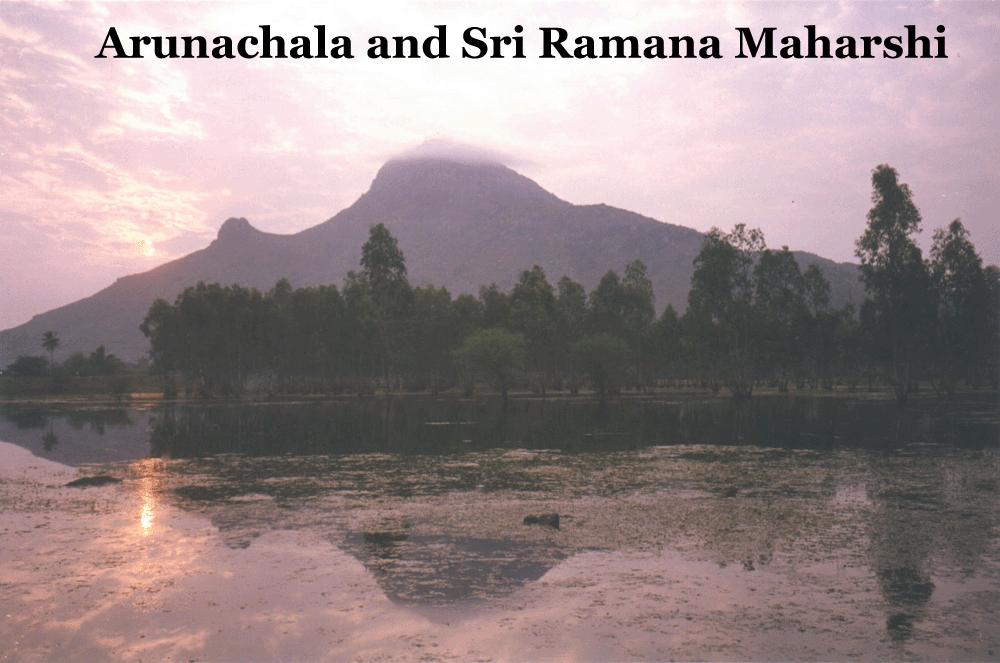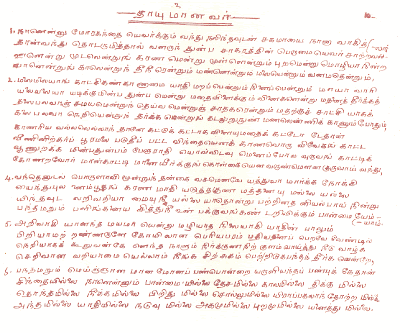Over the last few days a couple of readers have asked me about the contents of the Tamil parayana that was chanted during Bhagavan’s lifetime. I have located a list of the items, which I will give later in today’s post.
the world-illusion, manifesting as multiplicity, follows along behind.
Who might have the power to describe the vastness
of the ocean of misery that grows out of this:
as flesh; as the body; as the intellectual faculties;
as the inner and the outer; as the all-pervasive space;
as earth, water, fire, and air; as mountains and forests;
as the multitudinous and mountainous visible scenes;
as that which is invisible, such as remembering and forgetting;
as the joys and sorrows that crash upon us, wave upon wave, in maya’s ocean;
as the deeds that give rise to these;
as the religions of manifold origin that [try to] put an end to them;
as their gods, as their spiritual aspirants, and as the methods
described in many a treatise that bear witness to their practices;
and as the doctrinal wrangling amongst them?
It is like trying to count the fine grains of sand on the seashore.
In order to teach me to discern the truth
of how all these woes, impossible to measure –
which spontaneously accumulate, multiplying bundle by bundle –
were insubstantial, like the spectacle of a mountain of camphor
that disappears entirely at the touch of a flame,
he associated with food, sleep, joy, misery, name-and-place,
and wearing a bodily form similar to my own,
he came as the grace-bestowing Mauna Guru
to free me from defilement, in just the same way that a deer
is employed to lure another deer.
Coming thus, he claimed my body, my belongings, my very life
as his possessions, and teaching the path of rejection, he declared:
‘The five senses, the five elements, the organs of action, and all the rest,
you are not. You are none of these.
Nor are you any of the qualities that pertain to these.
You are not the body, nor are you knowledge and ignorance.
You are chit, the real, which is like a crystal,
reflecting the qualities of whatever is placed before it,
and yet having no connection with it.
It is my inherent nature to enlighten you
when I find that you are ripe for it.’
‘If you desire to gain the vast, supreme reality
that is the temple of refreshing grace,
inseparable from all that is, becoming pure consciousness
and obtaining the indestructible state whose nature is bliss,
listen as I explain to you the proper means:
May you live long, winning in your heart
the reality that is devoid of all qualities!
May you attain the state of bliss-consciousness,
so that all the dense accumulation of ignorance disappears!
May you liberate yourself from bondage!’
Through his grace, he imparted to me the state of mauna,
the true knowledge in which bondage is abolished:
‘For that state, there is no thought, no “I” sense,
no space, no time, no directions, no pairs of opposites,
nothing lost, nothing other, no words,
no phenomena of night and day,
no beginning, no end, no middle, no inner or outer.
Nothing is.’
‘When I say: “It is not, it is not”, this is not a state of nothingness.
It is pure identity; it is the nature that eternally endures,
a state that cannot be expressed in words.
It is the swarupa which engulfs everything,
so that neither ‘I’ nor anything else appears.
As the day consumes the night, it consumes ignorance entirely.
Easily overcoming and swallowing up your personal consciousness,
it transforms your very self, here and now, into its own Self.
It is the state that distinguishes itself as self-luminous silence.’
‘Other than the nature that is its own Self,
it allows nothing else to arise.
Because there is no other consciousness,
should anything attempt to arise there
it will, like a camphor flame, vanish.
The knower, devoid of both knowledge and objects known,
falls away, without falling, since it still remains.
But who can tell of its greatness, and to whom?
By dint of becoming That, one exists only as That.
That alone will speak for itself.’
‘If we call it “That”, then the question will arise, “What is That?”
Therefore did Janaka and the other kings
and the rishis, foremost among whom is Suka,
lived happily, like bees intoxicated with honey,
entirely avoiding any mention of “That”.
Remain in this state.’ Thus did he speak.
Grant me the abundance of your grace
so that, in the nirvikalpa state of total tranquillity,
I may know and attain the condition of supreme bliss,
in accordance with your rule.
I shall not sleep or take up any other work
until I attain this state.
The unique source [tan], fullness [purnam],
prevailed within, in my Heart
so that the ‘I’ which deemed itself
an independent entity
bowed its head in shame.
Conferring matchless bliss,
consuming my whole consciousness
and granting me the state of rapture,
it nurtured in me the condition of mauna.
This being so, what more is there to be said?
When the mind turns inwards seeking ‘Who am I?’ and merges in the Heart, then the ‘I’ hangs down his head in shame and the one ‘I’ appears as itself. Though it appears as ‘I-I’, it is not the ego. It is reality, perfection, the substance of the Self.







7 comments:
Thank you for putting up the translation of these marvellous Saint Thayumanavar verses, particularly as the verses are not translated in the book you mentioned. In my humble opinion, any verses chosen by Sri Bhagavan are significant spiritually & esp. so because He then went thro’ the trouble of painstakingly writing them out in His neat print-like hand.
So please do put up the translations to the SPP verses as well. And if you have a fresh translation to the verses by the mysterious Sri Satyamangala Venkataramaiyer, grateful to have that as well.
Also, if you would know, why are these 2 sets not in the hand-written notebook as reproduced ? The covering text does not also clarify whether Sri Bhagavan copied them out at all or whether they went missing from the notebook later on. And finally, what happened to the notebook itself – is it now lost ?
Many thanks
yeah please do post the selections from Sivaprakasam Pillai..i haven't read the original thayumanavar tamil verses but the translation is awesome, profound..thanks!
I found the information I posted yesterday in a 2002 reprint of this book, appendix one, starting on page 107. This information was not printed in the first edition. The Thayumanavar verses are printed in this 2002 edition, but the Sivprakasam Pillai verses are not. This is a paragraph from page 109:
All the above-mentioned works [listed on the fifteen-day cycle] were copied in the ashram parayana notebook and any devotees who were interested to join in the parayana would copy the verses in their own notebooks. However, Swami Sivananda, who was an attendant of Sri Bhagavan during the 1940s, knew that he could not copy all the verses without making many mistakes, so he requested Sri Bhagavan to copy them for him. Since no work was ever too small or insignificant for Sri Bhagavan to attend to, he painstakingly copied all the verses in his small and neat handwriting in a pocket-size notebook which he himself had bound. Since his attendant did not know any language or script other than Tamil, Sri Bhagavan also transliterated in Tamil script all the verses in Sanskrit, Telugu and Malayalam. And on page thirteen, above his verse 'karunar navamayk...' (which means, 'This is Arunachala Siva, who, being the ocean of grace, bestows liberation when meditated upon', and which is intended to be written below a picture of Arunachala) he drew a small sketch of the holy hill Arunachala.
It appears that Sri Bhagavan copied all these verses for Swami Sivananda sometime in the early 1940s, and hence this notebook does not contain Ekatma Panchakam and Atma Bodham, which were composed by Sri Bhagavan in 1947 and 1948 respectively. The notebook contains all the other works included in the Tamil parayana, and in the present book all the works copied by Bhagavan in the notebook are reproduced except Sri Ramana Stuti Panchakam and the works of Sivaprakasam Pillai.
------------
My understanding of these words is that the missing texts are in the original notebook, but an editorial decision was taken to exclude them from the printed version. The notebook itself is in the ashram archives.
I saw "The Fire of Freedom, Satsang with Papaji, Volume 1" as the title of your latest book on avadutha.com. Is there a Volume 2 coming up?
Mistake..I was planning to post the above comment on your 'Summa Iru' post..
Yes, but I haven't really started the work yet. I arranged with Kamal, the late president of Avadhuta, to make three volumes, after which I would review the material to see if I should continue the series. Most teachers seem to say the same thing again and again and a point is reached when books about them become a bit repetitive. I decided I would do three books of dialogues and then check the contents of the remaining satsangs I have transcripts of to see how much truly original material remained.
I have a few other jobs pending at the moment, but I want to get back to this series later this year.
hi...
I could not understand tamil parayana. Is telugu parayana available anywhere? I want to do parayana and know more about this. I could not understand properly in English too. It will be easy for me to read and understand about this in my mother tougue. can I know about this pls.. Thank you
Post a Comment